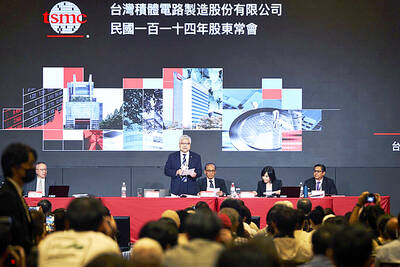The global market value of 3D printers is forecast to grow at a 20.4 percent compound annual growth rate to US$4.45 billion in 2016 from US$2.15 billion last year because of continued price decreases, Market Intelligence and Consulting Institute (MIC, 資策會) said in a report yesterday.
While expecting manufacturers to roll out more lower-priced models over the next two to three years, the growing choice of printing materials — such as metals, ceramics, resins, plastics, nylon, acrylonitrile butadiene styrene and wax — will help create demand for the printers, MIC said.
LOWER PRICES
“Low-priced printers allow users to produce a limited number, but various types of 3D objects quickly,” analyst Tony Wu (吳顯東) said in the report.
Cheaper printers would also enable businesses to shorten their time in product development, while the 3D objects can be used to evaluate consumer responses before companies start mass production, Wu said.
The institute considers 3D printers that cost less than US$5,000 to be low-priced models, saying that these models are suitable for individuals or owners of small-sized businesses.
Shipments of low-priced printers had grown 493 percent from 5,900 units in 2010 to 35,000 units last year, the institute said.
DIVERSIFIED USES
At present, 29 percent of 3D printers are used as consumer electronics, 19 percent in the car industry, 13 percent for medical purposes, 10 percent in schools, 8 percent in the aircraft components sector and 7 percent in the machinery industry, MIC said.
It said demand for low-priced 3D printers is expected to increase at a much faster rate, thanks to the launch of more free mobile apps used to print 3D objects.

With an approval rating of just two percent, Peruvian President Dina Boluarte might be the world’s most unpopular leader, according to pollsters. Protests greeted her rise to power 29 months ago, and have marked her entire term — joined by assorted scandals, investigations, controversies and a surge in gang violence. The 63-year-old is the target of a dozen probes, including for her alleged failure to declare gifts of luxury jewels and watches, a scandal inevitably dubbed “Rolexgate.” She is also under the microscope for a two-week undeclared absence for nose surgery — which she insists was medical, not cosmetic — and is

CAUTIOUS RECOVERY: While the manufacturing sector returned to growth amid the US-China trade truce, firms remain wary as uncertainty clouds the outlook, the CIER said The local manufacturing sector returned to expansion last month, as the official purchasing managers’ index (PMI) rose 2.1 points to 51.0, driven by a temporary easing in US-China trade tensions, the Chung-Hua Institution for Economic Research (CIER, 中華經濟研究院) said yesterday. The PMI gauges the health of the manufacturing industry, with readings above 50 indicating expansion and those below 50 signaling contraction. “Firms are not as pessimistic as they were in April, but they remain far from optimistic,” CIER president Lien Hsien-ming (連賢明) said at a news conference. The full impact of US tariff decisions is unlikely to become clear until later this month

GROWING CONCERN: Some senior Trump administration officials opposed the UAE expansion over fears that another TSMC project could jeopardize its US investment Taiwan Semiconductor Manufacturing Co (TSMC, 台積電) is evaluating building an advanced production facility in the United Arab Emirates (UAE) and has discussed the possibility with officials in US President Donald Trump’s administration, people familiar with the matter said, in a potentially major bet on the Middle East that would only come to fruition with Washington’s approval. The company has had multiple meetings in the past few months with US Special Envoy to the Middle East Steve Witkoff and officials from MGX, an influential investment vehicle overseen by the UAE president’s brother, the people said. The conversations are a continuation of talks that

CHIP DUTIES: TSMC said it voiced its concerns to Washington about tariffs, telling the US commerce department that it wants ‘fair treatment’ to protect its competitiveness Taiwan Semiconductor Manufacturing Co (TSMC, 台積電) yesterday reiterated robust business prospects for this year as strong artificial intelligence (AI) chip demand from Nvidia Corp and other customers would absorb the impacts of US tariffs. “The impact of tariffs would be indirect, as the custom tax is the importers’ responsibility, not the exporters,” TSMC chairman and chief executive officer C.C. Wei (魏哲家) said at the chipmaker’s annual shareholders’ meeting in Hsinchu City. TSMC’s business could be affected if people become reluctant to buy electronics due to inflated prices, Wei said. In addition, the chipmaker has voiced its concern to the US Department of Commerce